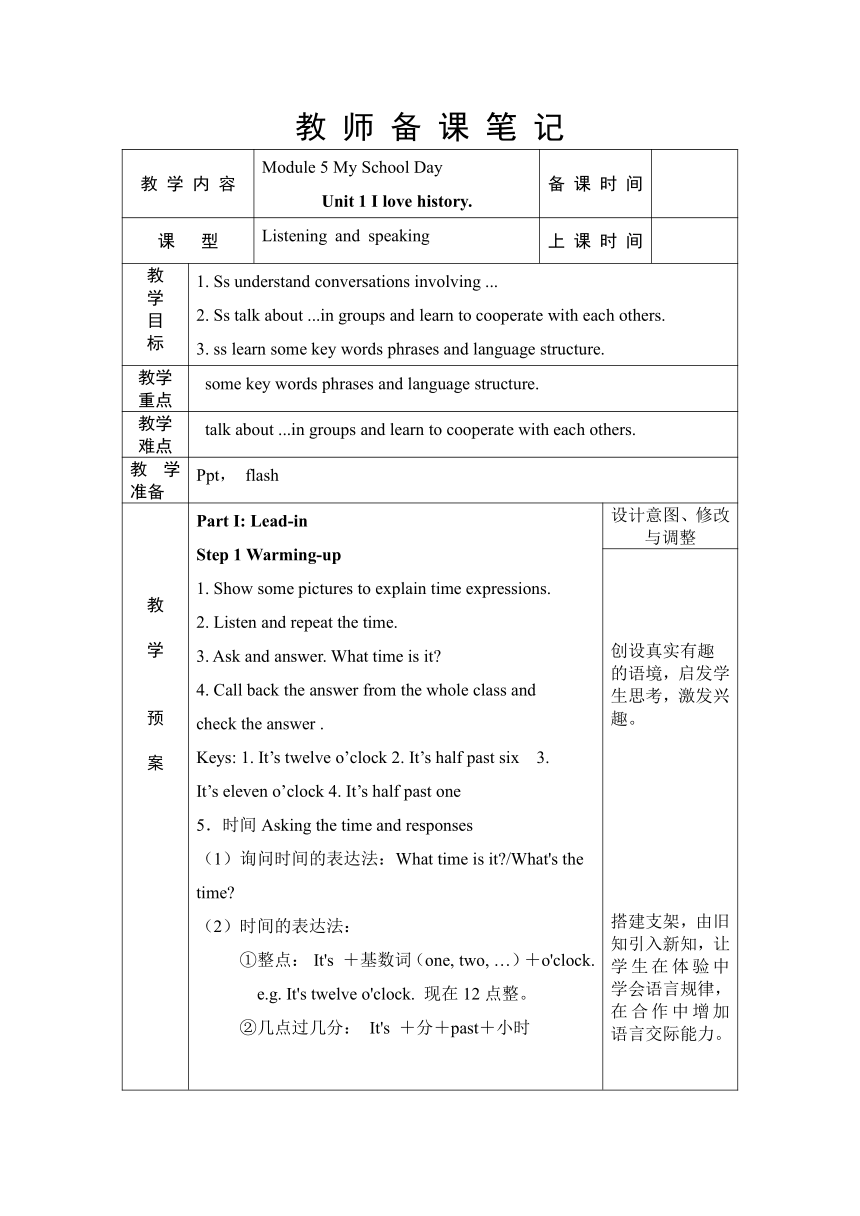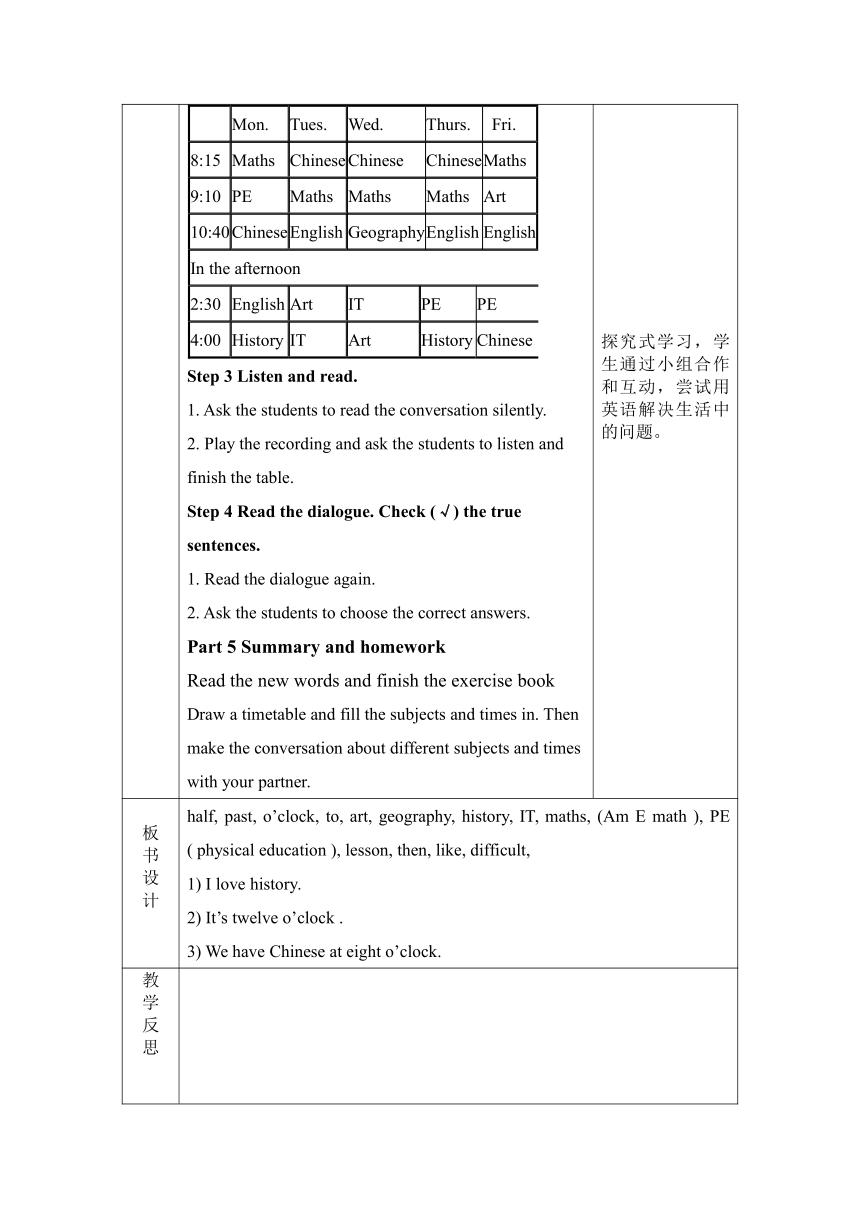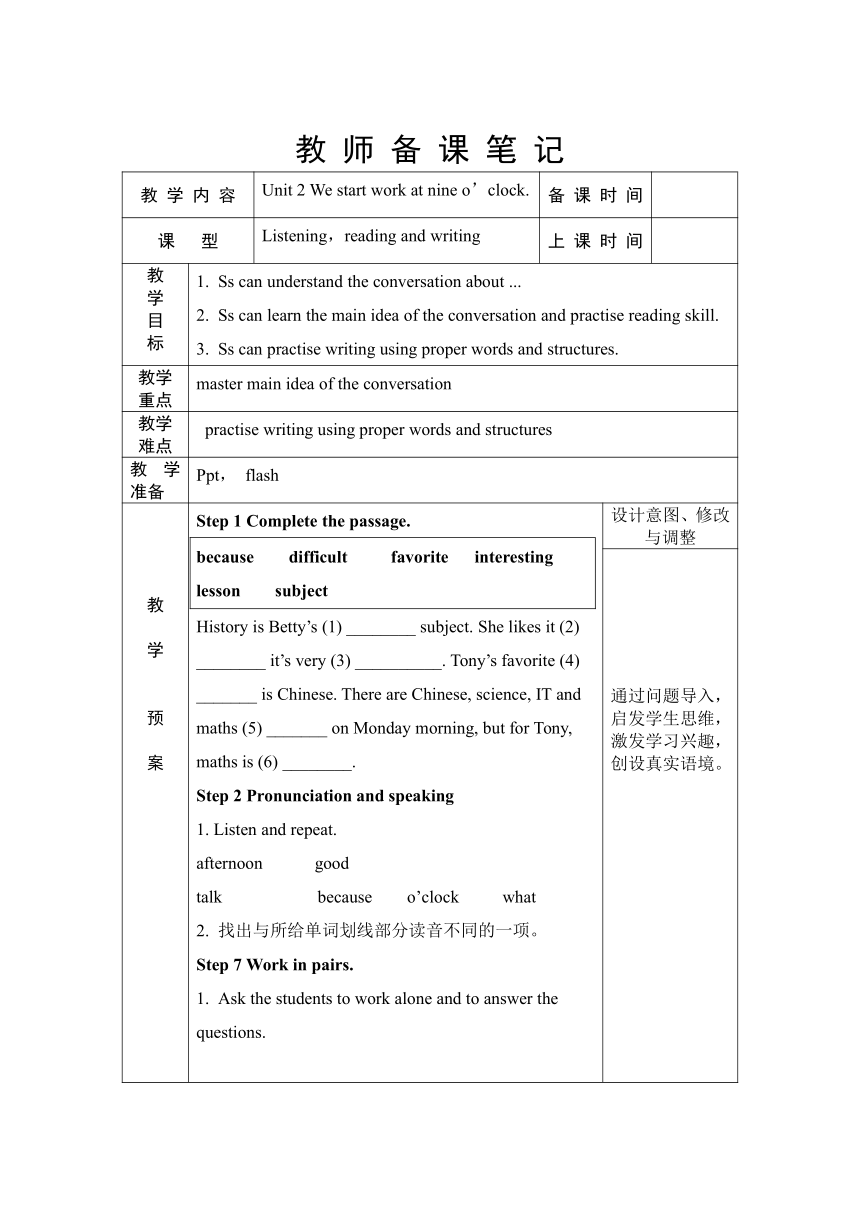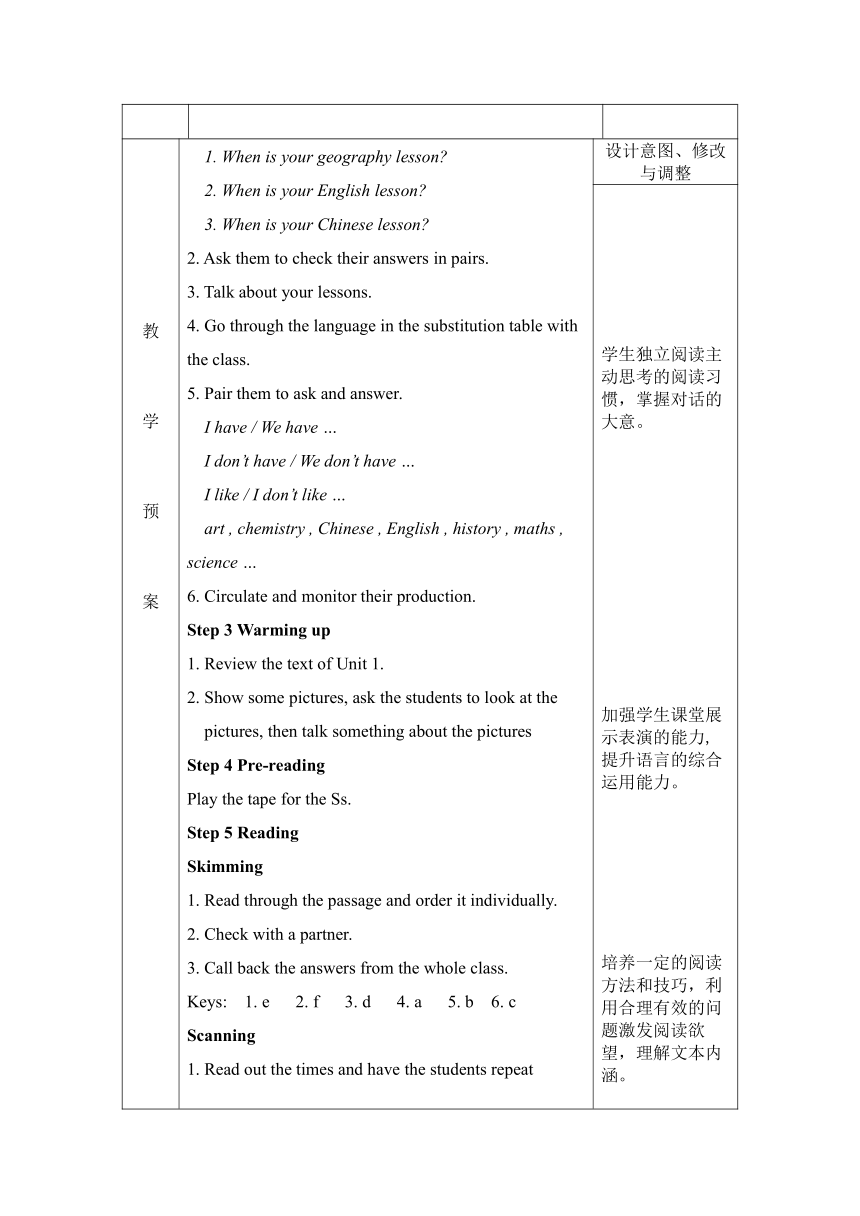Module 5 My school day 模块表格式教案
文档属性
| 名称 | Module 5 My school day 模块表格式教案 |  | |
| 格式 | docx | ||
| 文件大小 | 196.5KB | ||
| 资源类型 | 教案 | ||
| 版本资源 | 外研版 | ||
| 科目 | 英语 | ||
| 更新时间 | 2022-11-05 16:29:10 | ||
图片预览





文档简介
教 师 备 课 笔 记
教 学 内 容 Module 5 My School Day Unit 1 I love history. 备 课 时 间
课 型 Listening and speaking 上 课 时 间
教 学 目 标 1. Ss understand conversations involving ... 2. Ss talk about ...in groups and learn to cooperate with each others. 3. ss learn some key words phrases and language structure.
教学重点 some key words phrases and language structure.
教学难点 talk about ...in groups and learn to cooperate with each others.
教学准备 Ppt, flash
教 学 预 案 Part I: Lead-in Step 1 Warming-up 1. Show some pictures to explain time expressions. 2. Listen and repeat the time. 3. Ask and answer. What time is it 4. Call back the answer from the whole class and check the answer . Keys: 1. It’s twelve o’clock 2. It’s half past six 3. It’s eleven o’clock 4. It’s half past one 5.时间Asking the time and responses (1)询问时间的表达法:What time is it /What's the time (2)时间的表达法: ①整点: It's +基数词(one, two, …)+o'clock. e.g. It's twelve o'clock. 现在12点整。 ②几点过几分: It's +分+past+小时 设计意图、修改与调整
创设真实有趣的语境,启发学生思考,激发兴趣。 搭建支架,由旧知引入新知,让学生在体验中学会语言规律,在合作中增加语言交际能力。
教 学 预 案 ③几点差几分: It's+分+to+小时 e.g. It's twenty to six. 现在5:40。/现在6点差20。 注意:A、介词to, past前的分钟通常在30之内,但几点半,通常用介词past. e.g. It's half past six. 现在6:30。 B、时间的表达有一种简单的方法: 即直接用小时+分钟 e.g. It's eight twenty –five 现在8:25。 6. Practice. Ask and answer. What time is it Step 2 Practice 1. Show some pictures of the subjects. 2. Introduce the new words. 3. Match the words with the pictures. 4. Call back the answer from the whole class and check the answer . 5. Read the words. 6. Ask and answer about the timetable. What lesson do we have at… We have… When do we have… We have… at… Mon.Tues.Wed.Thurs. Fri.8:15Maths ChineseChineseChineseMaths9:10PEMathsMathsMathsArt10:40ChineseEnglishGeographyEnglishEnglishIn the afternoon2:30EnglishArtITPEPE4:00HistoryITArtHistoryChinese
Step 3 Listen and read. 1. Ask the students to read the conversation silently. 2. Play the recording and ask the students to listen and finish the table. Step 4 Read the dialogue. Check (√) the true sentences. 1. Read the dialogue again. 2. Ask the students to choose the correct answers. Part 5 Summary and homework Read the new words and finish the exercise book Draw a timetable and fill the subjects and times in. Then make the conversation about different subjects and times with your partner. 设计意图、修改与调整
通过自主合作和探究式的学习,提高学生参与度 教师再次播放录音,学生跟读、模仿。学生两人一组练习对话。 加强学生课堂展示表演的能力,提升语言的综合运用能力。 探究式学习,学生通过小组合作和互动,尝试用英语解决生活中的问题。
板 书 设 计 half, past, o’clock, to, art, geography, history, IT, maths, (Am E math ), PE ( physical education ), lesson, then, like, difficult, 1) I love history. 2) It’s twelve o’clock . 3) We have Chinese at eight o’clock.
教 学 反 思
教 师 备 课 笔 记
教 学 内 容 Unit 2 We start work at nine o’clock. 备 课 时 间
课 型 Listening,reading and writing 上 课 时 间
教 学 目 标 Ss can understand the conversation about ... Ss can learn the main idea of the conversation and practise reading skill. Ss can practise writing using proper words and structures.
教学重点 master main idea of the conversation
教学难点 practise writing using proper words and structures
教学准备 Ppt, flash
教 学 预 案 Step 1 Complete the passage. because difficult favorite interesting lesson subject History is Betty’s (1) ________ subject. She likes it (2) ________ it’s very (3) __________. Tony’s favorite (4) _______ is Chinese. There are Chinese, science, IT and maths (5) _______ on Monday morning, but for Tony, maths is (6) ________. Step 2 Pronunciation and speaking 1. Listen and repeat. afternoon good talk because o’clock what 2. 找出与所给单词划线部分读音不同的一项。 Step 7 Work in pairs. Ask the students to work alone and to answer the questions. 设计意图、修改与调整
通过问题导入,启发学生思维,激发学习兴趣,创设真实语境。
教 学 预 案 1. When is your geography lesson 2. When is your English lesson 3. When is your Chinese lesson 2. Ask them to check their answers in pairs. 3. Talk about your lessons. 4. Go through the language in the substitution table with the class. 5. Pair them to ask and answer. I have / We have … I don’t have / We don’t have … I like / I don’t like … art , chemistry , Chinese , English , history , maths , science … 6. Circulate and monitor their production. Step 3 Warming up 1. Review the text of Unit 1. 2. Show some pictures, ask the students to look at the pictures, then talk something about the pictures Step 4 Pre-reading Play the tape for the Ss. Step 5 Reading Skimming 1. Read through the passage and order it individually. 2. Check with a partner. 3. Call back the answers from the whole class. Keys: 1. e 2. f 3. d 4. a 5. b 6. c Scanning 1. Read out the times and have the students repeat them after you. 2. Ask them to match the times and the pictures individually. 3. Check with a partner. 4. Call back the answers from the whole class. Detailed reading Fill in the blanks about Alex’s school day. Post reading Ask the students to underline the correct answers. 1) I get up / start work at half past seven. 2) We have a break / have lunch at half past twelve. 3) I go home / watch TV in the evening. 4) I do my homework / see my friends in the evening. 5) I go home / go to sleep at ten o’clock. 3. Ask the students to check with a partner. 4. Play the recording again .Check the answers: Part 6 Summary and homework Read and recite the new words; finish the exercise book 设计意图、修改与调整
学生独立阅读主动思考的阅读习惯,掌握对话的大意。 加强学生课堂展示表演的能力,提升语言的综合运用能力。 培养一定的阅读方法和技巧,利用合理有效的问题激发阅读欲望,理解文本内涵。 学生通过小组合作和探究式的学习,尝试用英语解决现实生活中的问题。
板 书 设 计 , love, subject, because, interesting, talk, begin, when, weekday, house, start, work, break, 1) We don’t have maths. 2) —Do you like maths —Yes, I do. 3 In the evening, I watch TV and have dinner with my family.
教 学 反 思
教 师 备 课 笔 记
教 学 内 容 Module 5Unit 3 Language in use 备 课 时 间
课 型 Listening, reading and writing 上 课 时 间
教 学 目 标 Students can review some important words and expressions. Students can learn to cooperate with others and solve problems. Students can solve grammar difficulties individually and in groups.
教学重点 important words and expressions. cooperating with others.
教学难点 solve difficulties individually and in groups.
教学准备 Ppt, flash
教 学 预 案 Step 1 Writing and speaking. Look at the sentences. I get up at seven o’clock. I go to school at eight o’clock. I get up at seven o’clock, and then go to school at eight o’clock. and then 两个句子是并列关系,表承接或递进时,可用and then来连接。两个句子的 主语一致时,则后一个句子的主语可以省略,用and then连接前后两个并列关 系的动词,前后动词形式要一致。 Now join the sentences with and then. 1) In the morning, we get up. We go to school. 2) In the afternoon, we have lessons. We play football in the playground. 设计意图、修改与调整
依托有效的语境创设,启发学生思维,提升教学有效性。
教 学 预 案 3) In the evening, I have dinner. I do my homework. 4) In the evening, I do my homework. I go to bed. Step 2 Complete the sentences with the words from the box. 1. Read through the phrases with the whole class. 2. Ask the students to complete the sentences with the words from the box with a partner. 3. Call back the answers from the whole class, check the answers. because break homework interesting subject 1) We have maths after _______ today. 2) I like maths. It’s my favorite _______. 3) Our maths teacher is very good and she makes it __________. 4) I like it _______ it’s interesting. 5) I do my maths _________ first after school every day. Keys : 1) break 2) subject 3) because 4) interesting 5) homework Step 3 Around the world 1. Ask the students to look at the picture and discuss what they can see. 2. Read through the information with the whole class, and talk something about them. 3. Compare the information with what happens in China. Step 4 Module task: Talking about your ideal school day. 1. Complete the table with information about your ideal school day. 2. Look through Module 5 and find expressions to say what you do and enjoy every day. Step 5 行为动词的一般现在时 表达经常性或者习惯性的动作,就要使用一般现在时。 e.g. I do my homework in the evening. 我在晚上做作业。 如果表示的是现在的状态,也可以用一般现在时。 e.g. I know him very well. 我和他很熟。 肯定句中的行为动词一般现在时。 e.g. I play basketball in the playground. Part 6 Summary and homework Read and recite the conversation; finish the exercise book 设计意图、修改与调整
通过学生自主合作学习,体现学生主体地位,提高参与度。 复习并灵活运用目标词汇和句型,让学生在真实语境中学会用英语解决问题。 复习巩固重点句型和对话,鼓励学生大胆尝试,积极互动,形成有效语言输出。 小组合作,加强师生和生生互动,学生在探究式的学习中强化用英语解决现实命题。
板 书 设 计 have lunch, evening, watch, do, homework, bed, sleep, park, busy, wash, face, minute 1) I get up at half past seven in the morning and have breakfast. 2) I drink Cola or water
教 学 反 思
教 师 备 课 笔 记
教 学 内 容 Module 5 reviewing 备 课 时 间
课 型 Listening, reading and writing 上 课 时 间
教 学 目 标 Students can review some important words and expressions. Students can learn to cooperate with others and solve problems. Students can solve grammar difficulties individually and in groups.
教学重点 important words and expressions. cooperating with others.
教学难点 solve difficulties individually and in groups.
教学准备 Ppt, flash
教 学 预 案 Step 1 Language practice 1. Complete the sentences. 1) ____ _____ Chinese at eight o’clock. 我们8点上语文课。 2) ____ ______ ______ maths. 我们没有数学课。 3) ____ _____ ______ maths 你喜欢数学吗? Yes, ___ _____. 是的。 4) ___ ____ ________, I watch TV and have dinner with my family. 晚上我和家人一起看电视吃晚饭。 2. Ask the students to repeat the sentences in the box Step 2行为动词的一般现在时 表达经常性或者习惯性的动作,就要使用一般现在时。 e.g. I do my homework in the evening. 设计意图、修改与调整
通过创设真实有趣的语境,激发学生学习兴趣,启迪思维。
教 学 预 案 如果表示的是现在的状态,也可以用一般现在时。 e.g. I know him very well. 我和他很熟。 肯定句中的行为动词一般现在时。 e.g. I play basketball in the playground. You draw very well. Chen Xi and Chen Li eat breakfast at home. 一般现在时肯定句结构为“主语+谓语动词原形+其他”。 否定句中的行为动词一般现在时。 e.g. I don’t play basketball in the playground. We don’t like the blue chairs in the classroom. Chen Xi and Chen Li don’t eat breakfast at home. 一般现在时否定句结构为“主语+______ +谓语动词原形+其他”。 一般疑问句中的行为动词一般现在时。 e.g. Do you play basketball in the playground —Yes, I do. —No, I don’t. 一般现在时一般疑问句结构为“____+主语+谓语动词原形+其他 ”, 肯定回答为“Yes, 主语+do”,否定回答为“No, 主语+ don’t”。 do not的缩写是don’t 根据汉语意思完成英语句子。 1. 我在家吃午饭。 I ________________ at home. 2. 你们学习真努力。 You ________ really ________. 3. 他们在教学楼看电视。 They ______________ in the teaching building. 4. 我们在图书馆看书。 We ________ in the library. Work in pairs. Ask the students to talk about their activities in a week. 用在时间前的介词(at , in , on)的用法。 at常用来表示在某点时间,即“在几点几分; 在某一时刻”。 e.g. The man often gets to his office at 8:30. 另外,at还可以用在at night(在晚上),at last(最后),at weekends(在周末)at noon(在中午)等固定短语中。 on常用来表示“在某天或星期几”。另外,表示“在某天的上、下午或晚上”时,介词也用on。 e.g. on Sunday(在星期天), in表示“在某一段时间”,如某年、某月、某个季节 e.g. in 2008(在2008年) 在某一些固定短语中要用in e.g. in the morning, in the evening, Part 5 Summary and homework Read the new words and finish the exercise book 设计意图、修改与调整
加强自主、合作学习,通过生生对话和问题回答,加强学生综合理解能力。 通过合作与交流,让学生学会主动思考,将目标语言应用在真实语境中。 合理有效加强教师反馈与评价,学生灵活应用语言,形成高质量的语言输出。 学生通过自主和合作学习,探究生活中的问题,用英语做工具,分析并解决问题,提升语言综合运用能力。
板 书 设 计 一般现在时肯定句结构为“主语+谓语动词原形+其他”。 一般现在时否定句结构为“主语+______ +谓语动词原形+其他”。 on Sunday(在星期天), on weekends(在周末), in 2008(在2008年) in March(在三月) in summer(在夏天)
教 学 反 思
教 学 内 容 Module 5 My School Day Unit 1 I love history. 备 课 时 间
课 型 Listening and speaking 上 课 时 间
教 学 目 标 1. Ss understand conversations involving ... 2. Ss talk about ...in groups and learn to cooperate with each others. 3. ss learn some key words phrases and language structure.
教学重点 some key words phrases and language structure.
教学难点 talk about ...in groups and learn to cooperate with each others.
教学准备 Ppt, flash
教 学 预 案 Part I: Lead-in Step 1 Warming-up 1. Show some pictures to explain time expressions. 2. Listen and repeat the time. 3. Ask and answer. What time is it 4. Call back the answer from the whole class and check the answer . Keys: 1. It’s twelve o’clock 2. It’s half past six 3. It’s eleven o’clock 4. It’s half past one 5.时间Asking the time and responses (1)询问时间的表达法:What time is it /What's the time (2)时间的表达法: ①整点: It's +基数词(one, two, …)+o'clock. e.g. It's twelve o'clock. 现在12点整。 ②几点过几分: It's +分+past+小时 设计意图、修改与调整
创设真实有趣的语境,启发学生思考,激发兴趣。 搭建支架,由旧知引入新知,让学生在体验中学会语言规律,在合作中增加语言交际能力。
教 学 预 案 ③几点差几分: It's+分+to+小时 e.g. It's twenty to six. 现在5:40。/现在6点差20。 注意:A、介词to, past前的分钟通常在30之内,但几点半,通常用介词past. e.g. It's half past six. 现在6:30。 B、时间的表达有一种简单的方法: 即直接用小时+分钟 e.g. It's eight twenty –five 现在8:25。 6. Practice. Ask and answer. What time is it Step 2 Practice 1. Show some pictures of the subjects. 2. Introduce the new words. 3. Match the words with the pictures. 4. Call back the answer from the whole class and check the answer . 5. Read the words. 6. Ask and answer about the timetable. What lesson do we have at… We have… When do we have… We have… at… Mon.Tues.Wed.Thurs. Fri.8:15Maths ChineseChineseChineseMaths9:10PEMathsMathsMathsArt10:40ChineseEnglishGeographyEnglishEnglishIn the afternoon2:30EnglishArtITPEPE4:00HistoryITArtHistoryChinese
Step 3 Listen and read. 1. Ask the students to read the conversation silently. 2. Play the recording and ask the students to listen and finish the table. Step 4 Read the dialogue. Check (√) the true sentences. 1. Read the dialogue again. 2. Ask the students to choose the correct answers. Part 5 Summary and homework Read the new words and finish the exercise book Draw a timetable and fill the subjects and times in. Then make the conversation about different subjects and times with your partner. 设计意图、修改与调整
通过自主合作和探究式的学习,提高学生参与度 教师再次播放录音,学生跟读、模仿。学生两人一组练习对话。 加强学生课堂展示表演的能力,提升语言的综合运用能力。 探究式学习,学生通过小组合作和互动,尝试用英语解决生活中的问题。
板 书 设 计 half, past, o’clock, to, art, geography, history, IT, maths, (Am E math ), PE ( physical education ), lesson, then, like, difficult, 1) I love history. 2) It’s twelve o’clock . 3) We have Chinese at eight o’clock.
教 学 反 思
教 师 备 课 笔 记
教 学 内 容 Unit 2 We start work at nine o’clock. 备 课 时 间
课 型 Listening,reading and writing 上 课 时 间
教 学 目 标 Ss can understand the conversation about ... Ss can learn the main idea of the conversation and practise reading skill. Ss can practise writing using proper words and structures.
教学重点 master main idea of the conversation
教学难点 practise writing using proper words and structures
教学准备 Ppt, flash
教 学 预 案 Step 1 Complete the passage. because difficult favorite interesting lesson subject History is Betty’s (1) ________ subject. She likes it (2) ________ it’s very (3) __________. Tony’s favorite (4) _______ is Chinese. There are Chinese, science, IT and maths (5) _______ on Monday morning, but for Tony, maths is (6) ________. Step 2 Pronunciation and speaking 1. Listen and repeat. afternoon good talk because o’clock what 2. 找出与所给单词划线部分读音不同的一项。 Step 7 Work in pairs. Ask the students to work alone and to answer the questions. 设计意图、修改与调整
通过问题导入,启发学生思维,激发学习兴趣,创设真实语境。
教 学 预 案 1. When is your geography lesson 2. When is your English lesson 3. When is your Chinese lesson 2. Ask them to check their answers in pairs. 3. Talk about your lessons. 4. Go through the language in the substitution table with the class. 5. Pair them to ask and answer. I have / We have … I don’t have / We don’t have … I like / I don’t like … art , chemistry , Chinese , English , history , maths , science … 6. Circulate and monitor their production. Step 3 Warming up 1. Review the text of Unit 1. 2. Show some pictures, ask the students to look at the pictures, then talk something about the pictures Step 4 Pre-reading Play the tape for the Ss. Step 5 Reading Skimming 1. Read through the passage and order it individually. 2. Check with a partner. 3. Call back the answers from the whole class. Keys: 1. e 2. f 3. d 4. a 5. b 6. c Scanning 1. Read out the times and have the students repeat them after you. 2. Ask them to match the times and the pictures individually. 3. Check with a partner. 4. Call back the answers from the whole class. Detailed reading Fill in the blanks about Alex’s school day. Post reading Ask the students to underline the correct answers. 1) I get up / start work at half past seven. 2) We have a break / have lunch at half past twelve. 3) I go home / watch TV in the evening. 4) I do my homework / see my friends in the evening. 5) I go home / go to sleep at ten o’clock. 3. Ask the students to check with a partner. 4. Play the recording again .Check the answers: Part 6 Summary and homework Read and recite the new words; finish the exercise book 设计意图、修改与调整
学生独立阅读主动思考的阅读习惯,掌握对话的大意。 加强学生课堂展示表演的能力,提升语言的综合运用能力。 培养一定的阅读方法和技巧,利用合理有效的问题激发阅读欲望,理解文本内涵。 学生通过小组合作和探究式的学习,尝试用英语解决现实生活中的问题。
板 书 设 计 , love, subject, because, interesting, talk, begin, when, weekday, house, start, work, break, 1) We don’t have maths. 2) —Do you like maths —Yes, I do. 3 In the evening, I watch TV and have dinner with my family.
教 学 反 思
教 师 备 课 笔 记
教 学 内 容 Module 5Unit 3 Language in use 备 课 时 间
课 型 Listening, reading and writing 上 课 时 间
教 学 目 标 Students can review some important words and expressions. Students can learn to cooperate with others and solve problems. Students can solve grammar difficulties individually and in groups.
教学重点 important words and expressions. cooperating with others.
教学难点 solve difficulties individually and in groups.
教学准备 Ppt, flash
教 学 预 案 Step 1 Writing and speaking. Look at the sentences. I get up at seven o’clock. I go to school at eight o’clock. I get up at seven o’clock, and then go to school at eight o’clock. and then 两个句子是并列关系,表承接或递进时,可用and then来连接。两个句子的 主语一致时,则后一个句子的主语可以省略,用and then连接前后两个并列关 系的动词,前后动词形式要一致。 Now join the sentences with and then. 1) In the morning, we get up. We go to school. 2) In the afternoon, we have lessons. We play football in the playground. 设计意图、修改与调整
依托有效的语境创设,启发学生思维,提升教学有效性。
教 学 预 案 3) In the evening, I have dinner. I do my homework. 4) In the evening, I do my homework. I go to bed. Step 2 Complete the sentences with the words from the box. 1. Read through the phrases with the whole class. 2. Ask the students to complete the sentences with the words from the box with a partner. 3. Call back the answers from the whole class, check the answers. because break homework interesting subject 1) We have maths after _______ today. 2) I like maths. It’s my favorite _______. 3) Our maths teacher is very good and she makes it __________. 4) I like it _______ it’s interesting. 5) I do my maths _________ first after school every day. Keys : 1) break 2) subject 3) because 4) interesting 5) homework Step 3 Around the world 1. Ask the students to look at the picture and discuss what they can see. 2. Read through the information with the whole class, and talk something about them. 3. Compare the information with what happens in China. Step 4 Module task: Talking about your ideal school day. 1. Complete the table with information about your ideal school day. 2. Look through Module 5 and find expressions to say what you do and enjoy every day. Step 5 行为动词的一般现在时 表达经常性或者习惯性的动作,就要使用一般现在时。 e.g. I do my homework in the evening. 我在晚上做作业。 如果表示的是现在的状态,也可以用一般现在时。 e.g. I know him very well. 我和他很熟。 肯定句中的行为动词一般现在时。 e.g. I play basketball in the playground. Part 6 Summary and homework Read and recite the conversation; finish the exercise book 设计意图、修改与调整
通过学生自主合作学习,体现学生主体地位,提高参与度。 复习并灵活运用目标词汇和句型,让学生在真实语境中学会用英语解决问题。 复习巩固重点句型和对话,鼓励学生大胆尝试,积极互动,形成有效语言输出。 小组合作,加强师生和生生互动,学生在探究式的学习中强化用英语解决现实命题。
板 书 设 计 have lunch, evening, watch, do, homework, bed, sleep, park, busy, wash, face, minute 1) I get up at half past seven in the morning and have breakfast. 2) I drink Cola or water
教 学 反 思
教 师 备 课 笔 记
教 学 内 容 Module 5 reviewing 备 课 时 间
课 型 Listening, reading and writing 上 课 时 间
教 学 目 标 Students can review some important words and expressions. Students can learn to cooperate with others and solve problems. Students can solve grammar difficulties individually and in groups.
教学重点 important words and expressions. cooperating with others.
教学难点 solve difficulties individually and in groups.
教学准备 Ppt, flash
教 学 预 案 Step 1 Language practice 1. Complete the sentences. 1) ____ _____ Chinese at eight o’clock. 我们8点上语文课。 2) ____ ______ ______ maths. 我们没有数学课。 3) ____ _____ ______ maths 你喜欢数学吗? Yes, ___ _____. 是的。 4) ___ ____ ________, I watch TV and have dinner with my family. 晚上我和家人一起看电视吃晚饭。 2. Ask the students to repeat the sentences in the box Step 2行为动词的一般现在时 表达经常性或者习惯性的动作,就要使用一般现在时。 e.g. I do my homework in the evening. 设计意图、修改与调整
通过创设真实有趣的语境,激发学生学习兴趣,启迪思维。
教 学 预 案 如果表示的是现在的状态,也可以用一般现在时。 e.g. I know him very well. 我和他很熟。 肯定句中的行为动词一般现在时。 e.g. I play basketball in the playground. You draw very well. Chen Xi and Chen Li eat breakfast at home. 一般现在时肯定句结构为“主语+谓语动词原形+其他”。 否定句中的行为动词一般现在时。 e.g. I don’t play basketball in the playground. We don’t like the blue chairs in the classroom. Chen Xi and Chen Li don’t eat breakfast at home. 一般现在时否定句结构为“主语+______ +谓语动词原形+其他”。 一般疑问句中的行为动词一般现在时。 e.g. Do you play basketball in the playground —Yes, I do. —No, I don’t. 一般现在时一般疑问句结构为“____+主语+谓语动词原形+其他 ”, 肯定回答为“Yes, 主语+do”,否定回答为“No, 主语+ don’t”。 do not的缩写是don’t 根据汉语意思完成英语句子。 1. 我在家吃午饭。 I ________________ at home. 2. 你们学习真努力。 You ________ really ________. 3. 他们在教学楼看电视。 They ______________ in the teaching building. 4. 我们在图书馆看书。 We ________ in the library. Work in pairs. Ask the students to talk about their activities in a week. 用在时间前的介词(at , in , on)的用法。 at常用来表示在某点时间,即“在几点几分; 在某一时刻”。 e.g. The man often gets to his office at 8:30. 另外,at还可以用在at night(在晚上),at last(最后),at weekends(在周末)at noon(在中午)等固定短语中。 on常用来表示“在某天或星期几”。另外,表示“在某天的上、下午或晚上”时,介词也用on。 e.g. on Sunday(在星期天), in表示“在某一段时间”,如某年、某月、某个季节 e.g. in 2008(在2008年) 在某一些固定短语中要用in e.g. in the morning, in the evening, Part 5 Summary and homework Read the new words and finish the exercise book 设计意图、修改与调整
加强自主、合作学习,通过生生对话和问题回答,加强学生综合理解能力。 通过合作与交流,让学生学会主动思考,将目标语言应用在真实语境中。 合理有效加强教师反馈与评价,学生灵活应用语言,形成高质量的语言输出。 学生通过自主和合作学习,探究生活中的问题,用英语做工具,分析并解决问题,提升语言综合运用能力。
板 书 设 计 一般现在时肯定句结构为“主语+谓语动词原形+其他”。 一般现在时否定句结构为“主语+______ +谓语动词原形+其他”。 on Sunday(在星期天), on weekends(在周末), in 2008(在2008年) in March(在三月) in summer(在夏天)
教 学 反 思
同课章节目录
- Starte
- Module 1 My teacher and my friends
- Module 2 My English lesson
- Module 3 My English book
- Module 4 My everyday life
- Module 1 My classmates
- Unit 1 Nice to meet you.
- Unit 2 I'm Wang Lingling and I'm thirteen years ol
- Unit 3 Language in use.
- Module 2 My family
- Unit 1 Is this your mum?
- Unit 2 These are my parents.
- Unit 3 Language in use.
- Module 3 My school
- Unit 1 There are thirty students in my class.
- Unit 2 The library is on the left of the playgroun
- Unit 3 Language in use.
- Module 4 Healthy food
- Unit 1 We've got lots of apples.
- Unit 2 Is your food and drink healthy?
- Unit 3 Language in use.
- Module 5 My school day
- Unit 1 I love history.
- Unit 2 We start work at nine o'clock.
- Unit 3 Language in use.
- Revision module A
- Module 6 A trip to the zoo
- Unit 1 Does it eat meat?
- Unit 2 The tiger lives in Asia.
- Unit 3 Language in use.
- Module 7 Computers
- Unit 1 How do I write my homework on the computer?
- Unit 2 When do you use a computer?
- Unit 3 Language in use.
- Module 8 Choosing presents
- Unit 1 I always like birthday parties.
- Unit 2 She often goes to concerts.
- Unit 3 Language in use.
- Module 9 People and places
- Unit 1 We're enjoying the school trip a lot.
- Unit 2 They're waiting for buses or trains.
- Unit 3 Language in use.
- Module 10 Spring Festival
- Unit 1 Are you getting ready for Spring Festival?
- Unit 2 My mother's cleaning our houses and sweepin
- Unit 3 Language in use.
- Revision module B
